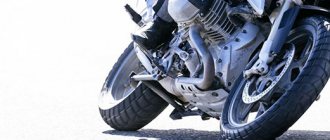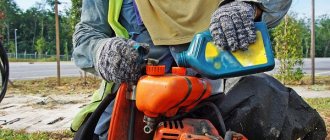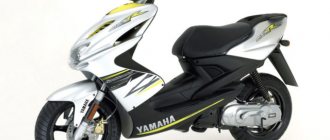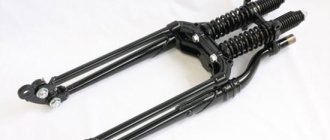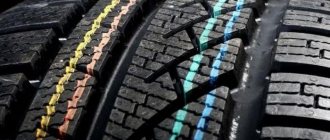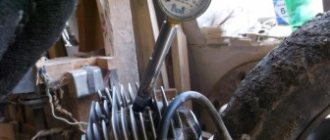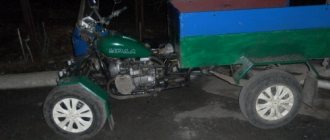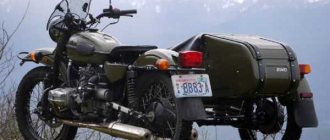Correct scooter tire pressure
To improve tire performance, increase engine efficiency, and ensure road stability, it is necessary to maintain the correct tire pressure.
They are designed in such a way that their shape must be maintained by internal pressure. If a tire is inflated correctly, it wears evenly and there is no deformation of the tread or sidewall of the tire. An overinflated tire has a smaller contact patch, which negatively affects directional stability, especially when cornering. The center portion of the tread will experience the most wear. The tire becomes very rigid and transfers vibrations from bumps on the road more strongly to the body of the scooter. The suspension suffers: bearings and silent blocks, as well as shock absorbers.
If the tire is underinflated, then the grip on the road is also insufficient, wear occurs on the side parts of the tread. Due to increased friction, the tire overheats, which leads to the destruction of the carcass. A 20% lack of pressure results in a 30% reduction in tire service life. In addition, rolling resistance increases, resulting in increased fuel consumption.
Therefore, the pressure must be maintained at the recommended level. If the tire fits well to the rim and has no punctures, then it practically does not deflate. However, the pressure must sometimes be checked, at least visually. If you get on a scooter and the tire is noticeably deformed, it means that it urgently needs to be inflated.
To measure pressure, instruments called pressure gauges are used. They can be mechanical (pointer) or digital electronic. Pressure gauges built into compressors are usually not very accurate. But they are suitable for a scooter.
To how many atmospheres should a scooter wheel be inflated?
The following figures are usually used: the front wheel of a scooter is inflated to 1.8 atm, and the rear wheel - to 2 atm. In winter, the pressure can be reduced by 0.1-0.2 atm.
You should always inflate a “cold” tire, that is, after a long period of inactivity, since when driving it heats up and the pressure increases.
Please note: This article and the images in it are subject to copyright. Partial or complete reproduction on other resources without permission is prohibited.
Source
What happens if you overinflate your tires?
A common mistake novice bikers make is overinflating tires due to the fact that in the first minutes after the start the pilot feels inconvenience and excess grip. If you overinflate the wheels, the contact patch will decrease, the traction characteristics will decrease, the ride will become harsh, and the likelihood of shaking and vibration will increase. Riding a bike with overinflated tires negatively affects the condition of the suspension. Over time, a part may become deformed, break, or require serious, expensive repairs.
Driving with overinflated inner tubes is especially dangerous in rainy weather. Due to poor contact with the road, motor vehicles may begin to skid when turning. In such conditions, the braking system does not always work properly, creating the preconditions for a traffic accident.
An unpleasant and dangerous consequence of overpumping is a decrease in strength and wear resistance. A motorcycle tire can simply explode while driving on a hot or uneven highway.
Riding on overinflated tires is only allowed in the following cases:
- the bike carries a passenger or transports a heavy load comparable to the weight of a person;
- during long high-speed trips.
Important! The pressure gauge readings can be increased by a couple of tenths during frosts. This will compensate for the low temperature and improve control.
Calculation of the recommended value
How to use the calculator?
The calculator is working in test mode! If you find an error in the indicators or want to leave suggestions, please send them through the feedback form on the Feedback page or the VK group! Errors with evidence (photos, screenshots, links) are accepted! All information presented on the site is for informational purposes only! Thanks for understanding!
Contents
Rules for maintaining optimal tire pressure
To be sure that the tires are inflated correctly, it is necessary to measure the pressure at least every two weeks, and always before each long trip.
If you have not used the moped for a long time, you should also check the pressure gauge readings with the required values. Even at rest, air leakage can occur due to pores in the rubber and the natural technical clearances of the wheel.
The variety of scooter models, differences in their size, weight and load that they are capable of carrying do not allow us to give the same recommendations for optimal tire inflation for mopeds with a capacity of 50, 150, etc. cubes at the same time. Therefore, we suggest you use a specially developed table of tire pressure parameters depending on the technical characteristics of your scooter:
| Tire size | Tire pressure, front/rear, bar | |
| Without load | With load | |
| 100/60-10 | 2.2/2.3 | 2.3/2.4 |
| 130/60-13 | 1 . 8/2 .0 | 2.0/2.2 |
| 130/70-12 | 2.2/2.3 | 2.3/2.4 |
| 120/70-12 | 2.25/2.3 | 2.3/2.4 |
| 110/70-12 | 2.2/2.3 | 2.3/2.4 |
| 120/80-12 | 1.8/2.0 | 2.0/2.2 |
| 130/70-10 | 1.8/2.0 | 2.0/2.2 |
| 100/90-10 | 1.9/2.1 | 2.0/2.2 |
| 120/90-10 | 1.8/2.0 | 2.0/2.2 |
| 130/90-10 | 1.9/2.1 | 2.0/2.2 |
| 3.0x10 | 1.75/2.0 | 2.0/2.1 |
| 3.50x10 4 PR | 2.5/2.5 | 2.6/2.6 |
Important! The parameters indicated on the tire are the maximum permissible value for this rubber. Do not use it as a reference when inflating moped tires.
Moped Delta
Operating manual for Delta moped
Technical characteristics of the Delta moped
| engine's type | four-stroke, single-cylinder |
| Engine capacity | 49.0 cm³ |
| Maximum power | 3.5 hp |
| Cooling system | air |
| Engine starting method | kick starter and electric starter |
| Ignition system | CDI |
| Spark plug | NHDG1137 |
| Fuel | gasoline A-92, A-95 |
| Oil | 15W/40 |
| Maximum speed | 50 km/h |
| Fuel consumption | 1.61l/100 km |
| Fuel tank volume | 2.5 l |
| Weight | 65 kg |
| Maximum load | 80 kg |
| Transmission | mechanical |
| Brakes | Drum type |
| Tires (front/rear) | 2.25-17 |
| Dimensions (l/w/h) | 1800/700/970 mm |
| Seat height | 780 mm |
| Base | 1170 mm |
| Ground clearance | 105 mm |
| Battery | 12V/7Ah |
Moped device
The location of the moped elements and control handles is shown in Fig. 1-3
1-Passenger footrest, 2-Electric starter, 3-Running footrest, 4-Rear brake pedal, 5-Frame number, 6-Trunk
1-Seat, 2-Fuel valve, 3-Gear shift pedal, 4-Footrest, 5-Central step, 6-Side step, 7-Passenger step.
1-Headlight switch, 2-Instrument panel, 3-Light switch, 4-Front brake handle, 5-Throttle handle, 6-Ignition switch, 7-Horn button, 8-Turn signal switch, 9-Clutch handle, 10-Fuel tank cap.
Moped operating instructions
Engine starting
To start the engine when cold, turn the fuel valve to the “ON” position. Then insert the key into the ignition and turn to the “ON” position. Set the gear shift pedal to the neutral position. Close the choke on the carburetor and gently press the kick starter lever several times, and then start the engine with a sharp press.
Starting a warm engine
Performed in the same sequence as when cold, but without closing the air damper. It is recommended to start a warm engine using an electric starter.
Start of movement
Braking
By turning the throttle control away from you, reduce the engine speed. Squeeze the clutch lever and simultaneously depress the front wheel brake lever and the rear wheel foot brake pedal with equal force. After stopping the moped, shift the gearbox to neutral, then release the clutch lever.
When braking a moped, use both brakes at the same time. By gradually increasing the force on the lever and brake pedal, you can ensure the most effective braking. Braking with only the front or rear wheel may cause the moped to skid or fall, so be extremely careful. When driving on wet or slippery asphalt, operate the braking system carefully and gently to prevent falling.
Stop
To stop the moped, turn the throttle control handle away from you to reduce the engine speed. Squeeze the clutch lever and simultaneously depress the front wheel brake lever and the rear wheel foot brake pedal with equal force. Shift the gearbox to neutral, then release the clutch lever. Turn off the engine. Place the moped on the kickstand.
Do not park the moped on a slope or soft ground to avoid it falling. To avoid burns, do not touch the hot exhaust pipe.
Running in a new moped
The first 1000 km are the most important for your moped. During this period, all parts of the moped grind against each other. Avoid operating the engine at maximum speed, overheating the engine and overloading it. For mileage from 0 to 1000km, we recommend the following operating modes:
150-500 km: avoid running the engine for a long time at a constant speed and do not open the throttle valve more than 2/3 of the stroke. It is forbidden to open the throttle valve completely, i.e. The engine should not reach its maximum speed.
1000 km: Avoid running the engine for a long time at a constant speed and do not open the throttle valve more than 3/4 stroke.
1000 km or more. Avoid running the engine for long periods of time at constant speed and with the throttle valve wide open. Change your driving speed occasionally.
At the first oil change (300 - 500 km), it is necessary to clean the filter mesh of the oil intake of the oil pump. Since this procedure involves removing the right crankcase cover, it is necessary that this operation be performed by service center mechanics.
Control: what to measure and what to measure in
Mechanical or electronic pressure gauges are used to measure the pressure in scooter tires. The accuracy class of these devices varies, so it is better not to save money and purchase an expensive but high-quality device. In the future, such a purchase will save you from more significant expenses.
Important! Do not try to gauge tire inflation by squeezing the tire with your fingers. The rigidity of the wheel at a pressure level of more than 1.5 atmospheres is such that it is impossible to determine the true indicators.
There are several accepted units for measuring pressure. On the territory of Russia, the main one is Atmosphere (1 atm. = 1 kgf/sq. cm), which is almost equal to the European Bar (1 bar = 0.98 atm). In the USA, PSI is used (1 psi = 1 pound/square inch or pound/square inch). Tire manufacturers use Kilopascal (1 kPa = 6.895 psi).
Units of measurement are converted into each other using the following formulas:
Rubber compound composition: the main factor in the durability of a motorcycle tire
Cord What is a tire made of? There are also differences inside the tire that are important when selecting. A motorcycle tire has a frame - this is its power part. It is responsible for strength (both from the inside of the tire and from the outside) when exposed to the road surface.
The frame consists of a single-layer or multi-layer cord - these are strong threads (polymer or steel bases) connected transversely with the thinnest and most elastic ones.
Cord threads can be created from:
- nylon;
- viscose;
- cotton
The most commonly used are steel. You can buy tires with Kevlar cords, but they are expensive. The frame is connected to the tread by a breaker - a shock absorber. It improves wear resistance. The cord threads in the breaker run diagonally. Next comes the tread. This is a particularly durable rubber with a pattern.
On a note.
The tread is responsible for wear resistance, road grip, noise, and vibration. Behind the tread is the side part of the tire, which combines the tread area and the frame. It's marked. There is a bead (edge, edge) at the end. This is the solid part of a motorcycle tire, the base of which is a steel ring, topped with a rubber cord.
Depending on the proportions in which the ingredients of the rubber mixture are mixed, different motorcycle tires are created. The production of rubber compounds is carried out by combining a rubber base or synthetic elastomers with special components that are fundamental to the type and quality of the finished product. Mixtures are:
- oil and petrol resistant;
- heat resistant;
- acid-resistant, also resistant to alkalis and ethers.
You might be interested in this About tire parameters for the Hyundai Creta
What causes incorrect air pressure in the wheels?
Failure to take pressure fluctuations in scooter tires seriously can lead to quite noticeable unpleasant consequences that directly threaten traffic safety.
Insufficient pumping can lead to the following problems
- the controllability of the scooter noticeably deteriorates, and a dangerous “wobble” appears when riding;
- wear of the side parts of the tread accelerates, creases in the rubber and peeling of the cord are possible;
- grip on the road surface increases, which requires additional fuel to overcome.
Winter wheels for scooters 10 and 12 inches
Just like on a car, the tires on a scooter change in winter. Winter tires for scooters have additional sipes with different depths, widths and shapes, which increase grip on the road surface, remove water and snow from the tread and prevent hydroplaning. To produce winter tires for scooters, a special composition is used that contains silicic acid and other substances that provide optimal grip on wet roads. In addition, winter tires are often equipped with special studs, which significantly improve the quality of vehicle control on ice.
Winter tires
Which size fits best and why?
The choice of size in this case is completely individual and depends on the preferences of the driver and the roads on which the scooter will be driven. Many experienced scooter owners advise purchasing a 12-inch size for riding on rough roads with potholes, since larger wheel sizes go through holes and potholes on the roads much better. For city roads, you can leave 10-inch tires on your scooter.
Maintenance Tips
To extend the life of your scooter's wheels, increase your own safety when riding and avoid additional costs for maintaining and operating your vehicle, follow a number of simple rules:
- control the pressure in the moped tires, avoiding both underinflated and overinflated wheels;
- do not forget to periodically pump up the wheels of a scooter that is temporarily not in use. This will help prevent cracks from appearing in the rubber and protect it from premature aging. The optimal pressure during this period is 1.5-2.0 atmospheres;
- be sure to double-check the pressure gauge readings before driving the scooter after it has been idle for a long time;
- Take measurements only on “cold” tires.
» frameborder=»0″ allow=»autoplay;
encrypted-media»allowfullscreen>»width=»320″ height=»240″> Source
Practical recommendations
To quickly set the tire pressure, you should use the rule - the pressure in the rear tire should not exceed 2.1-2.2 Atm. Pump up 2 atm in a cold state, then drive for 10-15 minutes in your usual mode on the road. Then, measure the pressure; if it exceeds 2.2 Atm, lower it; if not, pump it up. As a result of this step-by-step procedure, optimal pressure can be achieved.
A common mistake made by inexperienced bikers is overinflating the tire due to the fact that when starting to move, the pilot feels discomfort and excess tire grip. If everything is done correctly, the discomfort should go away after the air in the tire warms up. You should also not rely on the indicators of pressure gauges; sometimes inexpensive devices get knocked down and debris gets into them. In fact, on some pressure gauges the error can reach up to 0.5-0.8 Atm, which is a lot.
In addition to the level of tire inflation, it is important to pay attention to other characteristics of the wheels.
| Speed index | Maximum speed, km/h |
| A | 40 |
| B | 50 |
| C | 60 |
| D | 65 |
| E | 70 |
| F | 80 |
| G | 90 |
| J | 100 |
| K | 110 |
| L | 120 |
| M | 130 |
| N | 140 |
| P | 150 |
| Q | 160 |
| R | 170 |
| S | 180 |
| T | 190 |
| U | 200 |
| H | 210 |
| V | 240 |
| W | 270 |
| Y | 300 |
| VR | >210 |
| ZR | >240 |
| (W) | >270 |
| Z | >300 |
For example, the correct tire pressure for a Kawasaki motorcycle must also correspond to the tire speed index chart. In order to save money and due to lack of awareness, motorcycle owners can install low-index tires on motorcycles capable of accelerating to a speed of 240-280 km/h, which is strictly prohibited and can lead to tragic consequences.
Tire pressure monitoring
In fact, you should check the pressure before each trip, not necessarily with a pressure gauge, even just by eye, simply pressing the entire weight of your body on the seat, check if there is a significantly flat tire. The tire may have been punctured or otherwise damaged during your last trip. If this is the case, then be sure to fix the puncture; if you cannot do this manually, inflate the wheel a little more than the recommended rate and go to a tire shop.
Tire pressure table
On each tire you can find the recommended pressure , which should be adhered to. Typically this is 2 atm at the rear and 1.75 atm at the front. In the table you can find out what pressure should be depending on the tire size.
| Wheel size | Tire pressure, front/rear, kgf/cm2 (atm.) | |
| Normal load | Full load | |
| 100/60-10 | 2,2/2,3 | 2,3/2,4 |
| 130/60-13 | 1,8/2,0 | 2,0/2,2 |
| 130/70-12 | 2,2/2,3 | 2,3/2,4 |
| 120/70-12 | 2,25/2,3 | 2,3/2,4 |
| 110/70-12 | 2,2/2,3 | 2,3/2,4 |
| 120/80-12 | 1,8/2,0 | 2,0/2,2 |
| 130/70-10 | 1,8/2,0 | 2,0/2,2 |
| 100/90-10 | 1,9/2,1 | 2,0/2,2 |
| 120/90-10 | 1,8/2,0 | 2,0/2,2 |
| 130/90-10 | 1,9/2,1 | 2,0/2,2 |
| 3.0x10 | 1,75/2,0 | 2,0/2,1 |
| 3.50x10 4PR | 2,5/2,5 | 2,6/2,6 |
Indicators of air pressure that needs to be pumped into the wheels of popular models of 2T and 4T scooters:
| Model | Front wheel, atm | Rear wheel, atm |
| Moped Alpha 50cc | 1,72 | 2,2 |
| Moped Delta | 1,48 | 2,6 |
| Stealth Zion (as well as other Chinese 150cc scooters) | 1,7 | 2 |
| Honda Dio | 1,6 | 1,97 |
| Honda Tact | 1,58 | 1,95 |
Comments
0.5. But dealers pump 0.9 so that it doesn’t go down.
Login or register to comment.
I lift the front with a winch, and the back behind the tow bar with a jack.
Login or register to comment.
In terms of pressure, I pump 0.6-0.7, but only after it was sealed, before it was released and dismantled, I didn’t pump less than 1 atm.
Login or register to comment.
Login or register to comment.
I set the cameras to 13, because I’m tired of unboring, I download 0.7
Login or register to comment.
Are the cameras not being wiped?
Login or register to comment.
no, they don’t rub off, the flight is generally normal! The main thing is to buy Russian cameras, not Chinese ones, they have thicker tires)))
Login or register to comment.
Today I’ll go and get it, in my opinion it’s more practical, even if there’s a puncture, you can hold out without a repair kit on the pump.
Login or register to comment.
Many people install it, just don’t try to install it yourself, you’ll lose it, take it to a tire shop! I personally took it apart on the go five times before, and it wasn’t very pleasant! Cameras, by the way, are around 300 rubles apiece!
Login or register to comment.
Yes, this is a full race that you can’t put it on. it took 10 minutes for one wheel, but at the tire shop they told me that they don’t have such a machine to hook our disk, so I installed it in the garage myself (a P12 camera costs 220 rubles)
Login or register to comment.
the same ! I went to 4 tire shops, none of them were able to remove the wheels (the machines don’t have enough power)! at a tire pressure of 0.4 -0.5 the wheels were beaded. Now I'm downloading 0.9. Everything is good.
Login or register to comment.
Andrey, but for me it’s the other way around, I couldn’t do it at home at all, they did everything at a tire shop.
Login or register to comment.
I also installed cameras. I couldn’t do it myself, and not all tire shops could do it. Either the machine cannot turn (the tire was already cracking) or something else. They did everything at the 4th tire shop. At one time I also sealed the tires, but six months later it started again, and sealing them again is not an option, because... There were remnants of the old glue. Install cameras, download 05-07 and you will be happy
Login or register to comment.
I have 0.5 inflated. From the beginning I took it to the installation site with sealant, now everything is ok.
Login or register to comment.
Tell me what camera to take and where they can be? I've already suffered too. They put a camera in one tire on the tavern and now everything is humming. I want to put the same in the others, but I can’t find the cameras.
Login or register to comment.
I installed the simplest p13, the flight was normal for two years
Login or register to comment.
foks, two years and normal flight (your words). Write down what pressure you hold and how often you check the pressure and what you use to check it, or rather, what pressure meter you use. Thanks in advance.
Login or register to comment.
